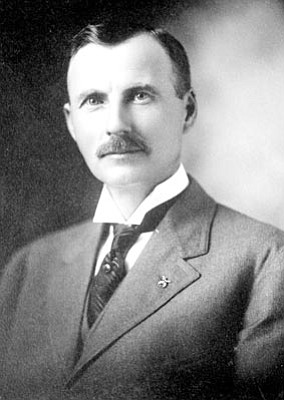By Parker Anderson
As we approach the 100th anniversary of Arizona's statehood, it's an apt time to remember a man who was at the forefront of the battle for statehood during its final years, but who is seldom (if ever) mentioned anymore in connection with the subject.
Ralph Henry Cameron was born in Southport, Maine, in 1863, the son of a fisherman. He became a fisherman himself as he grew to manhood, but apparently heard the "Go West, young man" call and, like many others before and after, set out across the plains.
Cameron arrived in the Arizona Territory in the early 1880s and, according to his later recollections, went to work for a time at the Riordan sawmill near Flagstaff. But Ralph was a very ambitious man. He and his brother Niles soon opened a mercantile store in Flagstaff.
Around this same time, the Cameron brothers began to take notice of the Grand Canyon, whose commercial development was in its infancy. Recognizing the potential there, the brothers sold their business and proceeded to lay mining claims all over the Grand Canyon, joining John Hance and Pete Berry as the first pioneer settlers on the south canyon rim. The Grand Canyon would initially make Ralph Cameron very successful, but would also prove to be his undoing, both in his lifetime and in the way Arizona remembers him.
It was Ralph and Niles Cameron who forged the Bright Angel Trail out of an old animal trail, a fact not widely remembered. They recognized the potential for tourism at the Grand Canyon and built a hotel at the rim. They also began charging a toll to use their Bright Angel Trail.
Ralph became involved in Flagstaff politics and was part of the movement to form Coconino County as a break-off from Yavapai County which, at that time, extended almost to the Utah border. After Coconino County was formed, he served as its sheriff in 1891 and 1894-1898.
The potential for tourist dollars always brings competition and within a few years the Santa Fe Railroad and the Fred Harvey Company started to move in to the Grand Canyon, taking legal steps to displace the Cameron brothers. Meanwhile, the U.S. government had also taken notice of the Grand Canyon, and talk began of turning it into a national monument or a national park.
With such large resources stacked against him, Ralph was facing difficult odds. He viewed the U.S. government's attempts to preserve the Grand Canyon as an infringement on mining and development as well as private property rights. He would spend more than 20 years in various courts battling the government on one hand and the Santa Fe Railroad and the Fred Harvey Company on the other. He was the textbook example of the "little guy battling big business" and, if it had been any land other than the Grand Canyon, he might well be remembered today as a hero. But it was the Grand Canyon. Because he fought so hard to keep it from being preserved, Grand Canyon historians do not discuss him very much, and when they do, it is with loathing.
Under U.S. mining laws, then and now, if your claim is not producing a certain amount of ore annually, it will be taken from you. It has often been alleged that Cameron falsified many of his mining reports in order to retain his holdings in the canyon and the increasingly profitable Bright Angel Trail. He ran for, and was elected to, the Coconino County Board of Supervisors around 1905 (in an effort to gain more leverage in his favor).
Ever since the Territory of Arizona was created in 1863 by President Abraham Lincoln, officials fought for statehood. Eastern lawmakers were strongly opposed to this as they viewed Arizona as a rough and lawless land filled with uncivilized people and criminals. The people of Arizona fought hard against this image for decades.
For many years, Arizona's Territorial delegate to the U.S. House of Representatives was Marcus Aurelius Smith, an attorney from Tombstone before heading for Washington. He had long promised to deliver statehood, but the years went by and the Arizona people were getting tired of waiting. There was talk that it was time to replace the illustrious Mr. Smith, a Democrat (the majority in Arizona at this time).
The ambitious Ralph Cameron saw his chance. In 1908, he announced his candidacy as a Republican for Arizona's Territorial delegate to the U.S. House, challenging the incumbent Mark Smith. His motives were twofold: He saw that going to Washington would increase his leverage in his battle with the U.S. government over the Grand Canyon and, at the same time, he genuinely cared about Arizona and its future, having a great passion for Arizona statehood.
Next week: Ralph Cameron's role in Arizona's statehood.
Library of Congress, Bain Collection/Courtesy
Ralph H. Cameron, seen here circa 1912, was a key figure in the battle for statehood.



